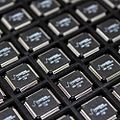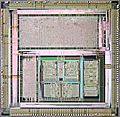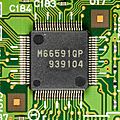Application-specific integrated circuit facts for kids
An ASIC (pronounced "AY-sick") stands for Application-specific integrated circuit. It's a special kind of integrated circuit (or computer chip) that is built for one specific job. Think of it like a tool made just for one task, instead of a general-purpose tool that can do many things. Most ASICs are for digital circuits, but some are for analog circuits too.
ASICs have some cool benefits:
- They can be made very small.
- They can work super fast.
- They use less electric power to do their job.
But there are also some downsides to ASICs:
- They can be expensive to make if you only need a few of them. This is because of the high cost of setting up the special tools needed for production.
- Designing them can be tricky and takes a lot of time. If there's a mistake, fixing it can be very costly and take even more time.
- The whole process of manufacturing them can take a long time.
Contents
How ASICs Are Designed
Designing an ASIC involves different methods. These methods help engineers create the best chip for its specific purpose. Some common design types include gate array, cell base, embedded array, standard cell, and structured ASIC designs.
Gate Array Design
Imagine a chip that already has many tiny, basic building blocks (like simple logic gates) laid out. In gate array design, engineers connect these existing blocks with special wires to create the circuit they need.
- Pros: It's quick and cheaper to make because the basic parts are mass-produced. Only the wiring needs to be custom-made.
- Cons: Because you're using pre-set blocks, it might not be the most efficient design, and not all parts of the chip might be used.
Cell Base Design
In cell base design, engineers use pre-designed, larger blocks of circuits, often called "cells." These cells are like ready-made sections that perform specific functions. Engineers arrange these cells and then add the necessary wires between them to complete the chip.
- Pros: Chips made this way often perform better than gate array designs.
- Cons: It takes longer to design and costs more than gate array designs because more parts are custom-arranged.
Embedded Array Design
Embedded array design is a mix of gate array and cell base designs. It uses some ready-made, larger functional blocks (like those in cell base design) and combines them with areas where engineers can add custom wiring, similar to gate arrays. It tries to get the best of both worlds.
Standard Cell Design
Standard cell design is a general term that can include gate array, cell base, and embedded array designs. It refers to using a library of pre-designed circuit blocks (standard cells) to build the chip. The exact way this is done can be different depending on the company.
Structured ASIC Design
Structured ASIC design focuses on using pre-made, larger parts of a system that can be customized quickly. This helps speed up the design and manufacturing process.
- Engineers who design ASICs often use special computer languages like Verilog or VHDL to describe how the chip should work. These languages are like blueprints for the chip's functions.
Images for kids
See also
 In Spanish: Circuito integrado de aplicación específica para niños
In Spanish: Circuito integrado de aplicación específica para niños





